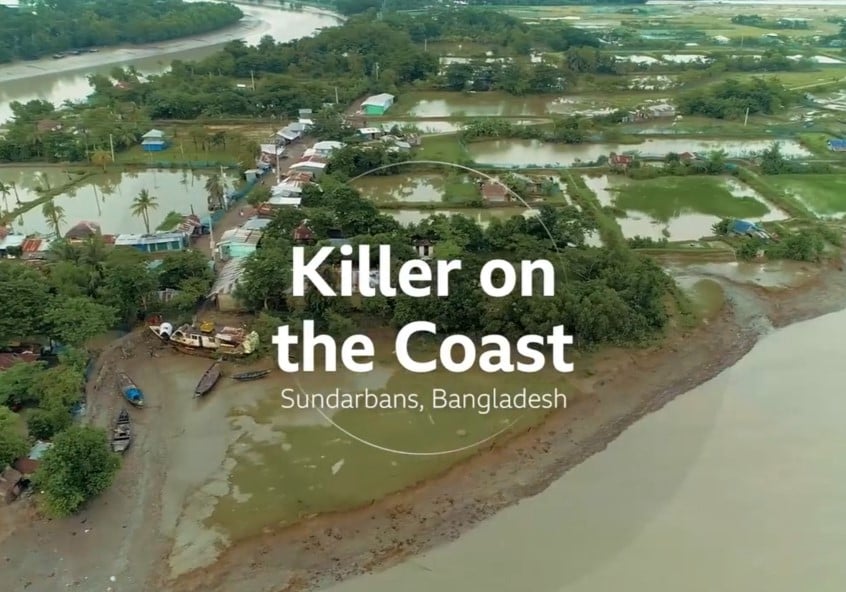Salinisation: the silent threat of salty water in South Bangladesh
London School of Hygiene & Tropical Medicine https://lshtm.ac.uk/themes/custom/lshtm/images/lshtm-logo-black.png Friday 22 March 2024
In a rural area in the District of Khulna, South Bangladesh, a researcher from the University of Dhaka asked me: “Do you want to taste the water yourself?” We were standing on an embankment, along the Rupsha River that leads into the Sundarbans - the largest continuous mangrove forest in the world. I had recently joined a research team from the University of Dhaka in their investigations into the unusually high number of pregnant women with pre-eclampsia in the area that was noticed by the local gynaecologist.
Whilst several hypotheses were formed, soon we started to suspect that the salty drinking water in the area could be part of the problem. Initially, I was sceptical: how much salt could someone really consume through water, and even if they did, would it not be a fraction of what they consume through food? I could not have been more wrong.
Unprotected drinking water sources nearby, such as ponds and to a certain extent shallow wells, were serving the population with extremely saline (salty) drinking water, without any alternatives to fall back on. We found levels up to 2.5g of salt per litre of drinking water. The WHO recommendation for salt consumption is less than 5 g/day. If people in this area of South Bangladesh drunk 2-3 litres of water from these sources per day (not a surprising amount given the heat) they were already consuming far more than the recommended amount without even taking the salt consumption through food into consideration.
Taking a sip of that water and struggling to swallow it did not only make these figures hit home, but also showed how the slowly worsening salinity in coastal Bangladesh caused people living there to gradually become used to very salty water. In fact, on more than one occasion I was told that bottled water tasted “flat”, and anecdotally the local gynaecologist said that people were adding salt to water for pregnant women in the rainy season as it tasted “too flat”.
The seriousness of the situation for people in areas with very little resources to adapt, such as in Bangladesh, is real. Climate change affects every component of their lives: floods destroy harvests, cause an increased risk of drowning, loss of livestock and assets. Droughts and heat result in both population health problems such as heat stroke and dehydration, and sanitation related health issues such as diarrhoeal diseases. There are reports of new, or an increased frequency of infectious disease outbreaks, as well as severe impacts on mental health. Salinity, is yet another threat and is somewhat 'silent': often people do not notice that they have salt-induced high blood pressure, yet it increases the risk of various chronic diseases. For pregnant women this is extremely dangerous as it substantially increases adverse pregnancy outcomes, including maternal and neonatal mortality.
It was the health of pregnant women in South Bangladesh that highlighted the impact of chronic exposure to extreme salt levels, as – unlike the general population – they required multiple health checks during pregnancy, in which the high blood pressure (and sometimes pre-eclampsia) was diagnosed. When the team later expanded the research to the general (non-pregnant) population, we realised that salinity caused a population-wide problem, though pregnant women (and their unborn children) were more vulnerable to the detrimental health effects this could cause.
The salt levels in drinking water are so high in coastal Bangladesh due to a number of climate change-related impacts, such as an increased frequency of tropical cyclones and floods, sea level rise, and reduced water levels in rivers that usually prevent sea water from encroaching into land through the riverbeds. However, some factors involved are manmade, such as large dams built further upstream which aggravate the salinity problems in the coastal areas. In addition, farmers that see yields declining because of the saline water exacerbate the problem by changing from crop to shrimp farming, breaking embankments to let in sea water onto their fields.
Coastal Bangladesh is not the only area being affected by salinisation; coastal areas from Australia to Africa and from other parts of Asia to North America are also facing increasing salinity, affecting both drinking and irrigation water. But there are things that can be done: many organisations are working around the clock to find sustainable solutions for the water salinity problem. In Bangladesh, for example, an organisation called BRAC have installed systems to harvest rainwater to provide clean water in the dry season, as well as introducing farmers to new techniques that enable them to grow crops all year round, in the face of salinisation. Hypertension (high blood pressure) is – in many cases – reversable, and a stable supply to safe drinking water should reduce blood pressure in the population.
Sipping my water on that embankment was a humbling experience, and it increased my drive to keep advocating for transformative mitigation actions in high-income countries such as the UK, who have historically contributed the most to climate change, and continue to do so now. The work that organisations such as BRAC are doing is life-changing for so many people in coastal areas in Bangladesh, and, having witnessed their skills and drive to make a change, I’m hopeful that we can stop and even reverse some of these impacts that the climate crisis has on populations such as those in coastal Bangladesh.
Watch the short BBC film ‘Killer on the Coast, Sundarbarns, Bangladesh’ to find out more.
LSHTM's short courses provide opportunities to study specialised topics across a broad range of public and global health fields. From AMR to vaccines, travel medicine to clinical trials, and modelling to malaria, refresh your skills and join one of our short courses today.